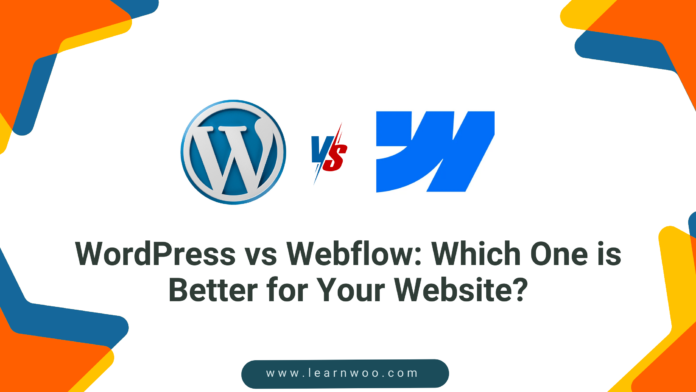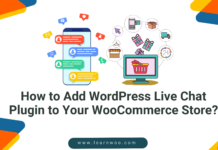The selection of the right system for creating a website is of paramount significance. Among the most usual platforms mentioned on these topics are WP and WBL.
WordPress came into existence with the first-ever website launched and many sites to date come into existence on this platform. It is made in a user-friendly way, with a large number of themes and plugins at its disposal.
In contrast, Webflow has been on the rise because of its ability to have a simplified user interface in the design of websites and because it allows someone to develop a website without ever writing any code.

With that being said we have discussed further below in more detail about WordPress vs Webflow, the following comparison of the sites is based on the comparison of the main features of the sites to assist you in deciding which platform suits your needs the best, as both platforms work in the framework of the web hosting site.
What is WordPress?
WordPress is one of the most popular content management platforms because of its usability and ease of website content production. It is like a digital toolbox that helps create websites by providing people with what they need to build competent websites without technical knowledge.
WordPress opens the canvas for creating and designing a user’s intent across online spaces as a blogger, entrepreneur, or developer.
At first, WordPress was just about creating content via a content management system (CMS).
This means that you can easily include text and graphics or video and other content you want to see on your site that would affect how it looks. The benefits of using WordPress include a rich choice of templates and add-ons that let you adjust the design and functions of the site according to your specifications.
Open source means it creates, develops, and improves more gradually than its counterparts, encouraging millions of website makers worldwide to use it.
Advantages of Using WordPress
Here are the advantages of using WordPress, elaborated:
Ease of Use: WordPress is easy to use, and one of its admiring features is that it is friendly to first-timers and professionals. Creating and managing content on WordPress differs from what can be considered problematic, mainly due to its user-friendly dashboard and editor.
Vast Theme and Plugin Ecosystem: WordPress allows users to choose from many thousands of available themes and plugins that can influence the look and feel of the site. Whether you need a visual design or require something specific, such as a contact form and e-commerce capabilities, a plugin or theme will provide it.
Flexibility and Scalability: WordPress is easy to adjust and expand to the requirements of any business. If the business needs to expand, it can begin with a blog that can be transformed into an e-shop or a corporate website. Another approach used by WordPress is module-based development, which simplifies the creation of software and the addition of new options.
Search Engine Optimization (SEO) Friendly: WordPress uses many SEO best practices when writers compose content. These features include customizable permalinks, meta tags, site maps, and SEO plugins that enhance the site’s ranking in search engines.
Active Community Support: As an open-source software platform, WordPress boasts an active community of developers, web designers, and those using the platform. There are channels where you can seek help, learn new ways of getting out of what you are facing, or even report a problem using the platform.
Regular Updates and Security: WordPress offers periodic updates to enhance usability, add new functions, and boost security. You can update your site with a single button, keeping you updated with WordPress’s latest and most secure version.
Mobile Responsiveness: Nearly all WordPress themes are ‘mobile-friendly,’ the site will adapt well to other devices like tablets and smartphones. This is especially important for users who want to interchange or transform their devices from one size to another without disconnection of service.
Content Management: WordPress shines as a CMS because it gives you the control to organize and manage content smoothly. It can also add menus, categories, tags, custom post types, and post scheduling, which makes keeping a well-structured, updated site simple.
Affordability: WordPress is also free, and many themes and plugins can be downloaded at a meagre cost or free of charge. It is also affordable for those who are just starting their venture and want to avoid investing in a website.
Disadvantages of Using WordPress
Here are some disadvantages of using WordPress, elaborated:
Learning Curve: WordPress is not complicated but has certain aspects that must be understood to use this platform efficiently. It is beneficial for beginners, even though the user might need help figuring out where to start, as some topics or plugins are pretty complex.
Security Vulnerabilities: WordPress is chosen as a platform and is a common target for hackers. Themes or plugins with poorly written code, outdated systems, or even weak passwords can be responsible for security vulnerability and exposure. Regular updates and other security features must be available to overcome these drawbacks.
Performance Issues: If a WordPress website is not well optimized, its chances of performing optimally are low. Overcomplicated themes, using more plugins than necessary, or too little or unconfident hosting cause slow loading and a poor user experience.
Dependency on Plugins: WordPress has numerous plugins to expand your website’s capacity even further, but the overuse of plugins makes your site incompatible, slow, or vulnerable. This does not mean entirely opting away from using the plugins; instead, choose some carefully and others judiciously.
Customization Limitations: Although relatively flexible, it may not work perfectly with overly modified designs or advanced functions. Complex layouts or design elements usually require a high level of technical craft, creativity, or even unique customization.
Maintenance Overhead: WordPress Maintenance involves updates, backups, security and vulnerability detection, and performance and technical optimization. This continued maintenance can be time-consuming and will most likely require someone tech-savvy.
Costs Add Up: It is worth mentioning that WordPress is a free platform, but the cost of purchases of premium topics, plugins, a hosting service, and other services cannot be avoided. Planning for these costs, especially for themes at a premium rate or using the most relevant and essential plugins, is crucial for a professionally managed website.
Content Ownership: It’s a self-hosted platform where you are responsible for the content on your site and the creation of site backups. This gives you control, but the security of the data and the backup is solely the user’s responsibility.
Lack of Official Support: Some of WordPress’s benefits are the official support channels provided to free users. Relying on official forums, official documentation, or third-party support can also be problematic.
What is Webflow?
Webflow is an online tool for designing and developing websites for people who do not understand coding. It offers simple but intuitive graphic images for designers and complicated or sophisticated development tools for business users.
Webflow also allows you to manage your website’s design at an element level, with native controls to edit layouts, typography, animations, interactions, and more. It is also responsible for performing tasks such as optimizing your code behind the scenes to make your site faster and easier to use for both people and search engines.
Webflow also has hosting capabilities, where you can directly post your site from the platform and manage domains, security, backups, and analytics. Finally, designing a website becomes less cumbersome and consumes less time, especially in the traditional way, as with Webflow.
Advantages of Using Webflow
Visual Design Interface: Web flow’s interface feature makes website design possible without the use of codes. Thus, it is a perfect website design tool for designers who are not into codes. The user will not have to write even one line of code and will be able to edit any layout for each page, as well as typography and animations.
Responsive Design: Webflow also creates responsive modes when you use it to ensure that your website will be viewable and functional on desktops, tablets or smartphones. It is crucial because it allows a site to use any screen size without compromising the UX.
Clean Code Generation: On the other hand, Webflow outputs HTML/CSS/JS codes in their pure and unmodified optimized form, just like other editors. This means that the site will be fast-loading and search engine optimized, as well as meet high standards of website accessibility and performance.
Powerful CMS Capabilities: Content management systems are one of the best features that Webflow offers for websites. They enable you to organize content in an easy-to-manage way and add and modify content whenever desired without republishing the website.
Custom Interactions and Animations: With Webflow’s interactions and animations, you can animate, transition, and scroll elements without writing code. This creates visual and interactive interest on the website and helps maintain user interest.
E-commerce Functionality: Webflow has an e-commerce capability to create and manage online stores. It will enable you to create and edit products, configure payment methods, keep track of orders, and personalize your customer’s shopping process.
Hosting Services: Webflow hosts your website with secure HTTPS hosting and SSL certificates, automatic backups, and custom domains. This saves the host from using third-party hosting providers and makes it easy to deploy.
Collaboration and Team Workflows: Webflow also supports collaborative tools like team workflows, where multiple users can work on the same project simultaneously. It provides access control and the ability to trace changes and manage workflow for designers, developers, and content creators.
Community and Support: Webflow also has an active community that networks and exchanges resources, documentation, and recommendations. It includes documentation, tutorials, and support forums to aid first-time users.
Disadvantages of Using Webflow
Learning Curve: Webflow’s visual design environment may seem somewhat straightforward at first glance, but it can be challenging for newbies to understand and navigate the entire range of Webflow’s tools and functions. There is little doubt that familiarising oneself with the platform, its terminology, design and workflow can take time and effort.
Limited Customization with Templates: A plethora of Webflow templates are available to help you develop the design faster, but these templates may need more functionality. Some functionalities or design modifications may involve advanced knowledge of Webflow or require coding from scratch.
Dependency on Webflow Platform: All websites developed using Webflow are hosted on the Webflow platform. This is convenient, and Webflow can easily integrate its functions into the site. However, this can also mean customers become dependent on Webflow hosting services. Moving from one provider to another may be a time-consuming process of manual settings and transfers.
Cost of Hosting and Plans: Webflow supports different packages and charges hosting fees. The platform is helpful regarding its features and hosting services, but the costs are likely to increase for some of the advanced plans or projects. Ongoing hosting charges and maintenance plans should be included in the budget.
Learning Curve for Custom Code: Customizing Webflow requires no coding skills; however, a solid understanding of HTML/CSS/JavaScript may be beneficial when building or adding complex functionality to your site. Beginning beginners in the coding field may need help performing advanced modifications or identifying and fixing errors with the model.
Limited SEO Control: Webflow offers basic SEO features like meta tags, URLs, and sitemaps. Still, some may say that the features are limited to the platform and do not meet SEO standards and basics compared to other SEO tools or platforms. Another strategy that may necessitate the use of separate tools or the engagement of someone with a higher level of expertise is the focus on advanced SEO techniques and the measurement of specific metrics.
Platform Reliability and Downtime: Such outages or issues are typically inevitable when using an online website builder like Webflow. You may be tempted to rely on the platform’s uptime and performance during such periods, but this might lead to sub-optimal serviceability of your website to your users.
Dependency on Webflow Updates: Webflow undergoes constant changes and updates, introducing new features and updates to enhance the site. However, changes in the application may negatively affect users’ workflows because some features may change or even disappear, and new ones may be added, which requires learning the latest options.
Conclusion
Therefore, this comparison WordPress vs Webflow are equally effective tools for creating websites and are only differentiated by some aspects and circumstances of use.
WordPress boasts a rich library of themes and plugins for all its features that enhance customization and community support. It is ideal for usability, expandability, and even many website categories.
In contrast, Webflow is a visual design interface that includes hosting, which is best for users who want a cleaner design, an easy-to-use interface, the ability to design and code simply, and all-inclusive hosting access.
Before deciding which platform to buy, some considerations are made regarding the design process, host requirements, custom features, learning curve, community, support, and pricing. I found out that both platforms can offer professional and valuable sites. If you cannot develop your website according to your goals and workflow, you should evaluate your priorities and choose the most appropriate platform.
Further Reading
- WordPress vs. Etsy (Comparison)
- WordPress vs. Adobe Commerce: Which One to Choose?
- Which is the Best CMS for your eCommerce Business – WordPress Vs. Joomla Vs. Magento?









